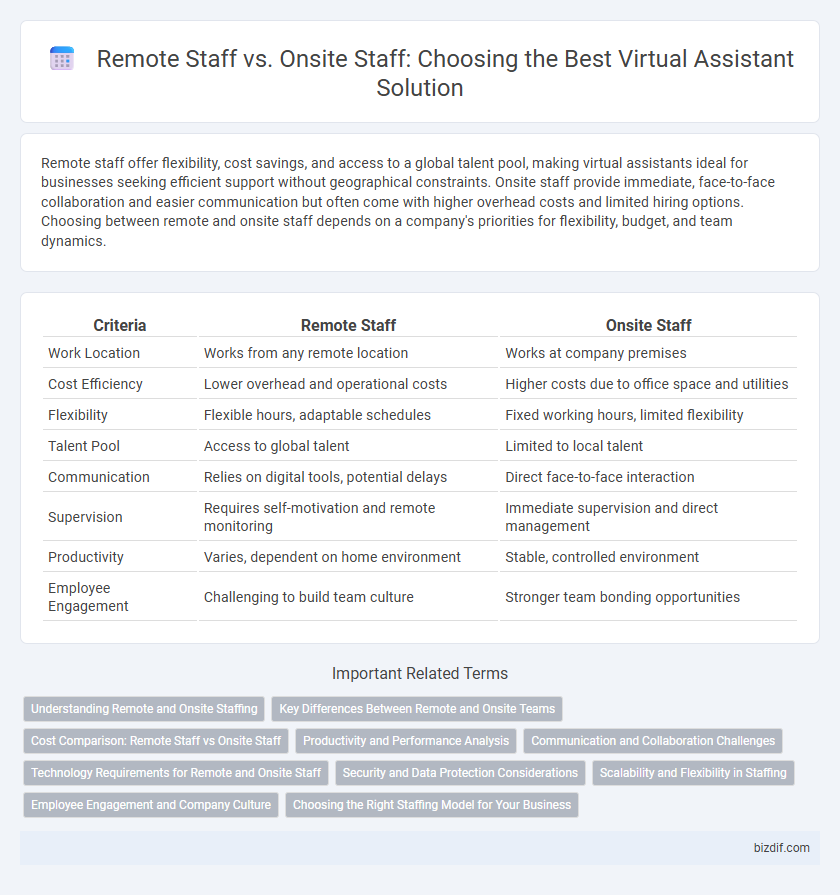Remote staff offer flexibility, cost savings, and access to a global talent pool, making virtual assistants ideal for businesses seeking efficient support without geographical constraints. Onsite staff provide immediate, face-to-face collaboration and easier communication but often come with higher overhead costs and limited hiring options. Choosing between remote and onsite staff depends on a company's priorities for flexibility, budget, and team dynamics.
Table of Comparison
| Criteria | Remote Staff | Onsite Staff |
|---|---|---|
| Work Location | Works from any remote location | Works at company premises |
| Cost Efficiency | Lower overhead and operational costs | Higher costs due to office space and utilities |
| Flexibility | Flexible hours, adaptable schedules | Fixed working hours, limited flexibility |
| Talent Pool | Access to global talent | Limited to local talent |
| Communication | Relies on digital tools, potential delays | Direct face-to-face interaction |
| Supervision | Requires self-motivation and remote monitoring | Immediate supervision and direct management |
| Productivity | Varies, dependent on home environment | Stable, controlled environment |
| Employee Engagement | Challenging to build team culture | Stronger team bonding opportunities |
Understanding Remote and Onsite Staffing
Remote staff offer flexibility and access to a global talent pool, reducing overhead costs associated with physical office spaces. Onsite staff provide direct supervision and foster immediate collaboration, benefiting tasks requiring hands-on interaction. Understanding the distinct advantages of remote and onsite staffing is crucial for optimizing workforce efficiency and project outcomes.
Key Differences Between Remote and Onsite Teams
Remote staff offer flexibility and access to a global talent pool, leading to diverse skill sets and cost savings on physical office space. Onsite teams provide immediate face-to-face communication, fostering stronger team cohesion and real-time collaboration. Key differences include communication methods, employee management challenges, productivity tracking, and infrastructure requirements.
Cost Comparison: Remote Staff vs Onsite Staff
Remote staff typically reduce overhead costs by eliminating expenses such as office space, utilities, and commuting allowances, leading to significant savings compared to onsite staff. Onsite employees often incur higher costs due to facility maintenance and equipment provisioning required for in-person work environments. Businesses leveraging remote teams benefit from flexible pay structures and access to global talent pools, optimizing operational budgets without compromising productivity.
Productivity and Performance Analysis
Remote staff often demonstrate higher productivity levels due to reduced commuting stress and flexible work environments, enabling focused task execution. Performance analysis reveals that virtual assistants benefit from real-time tracking tools and digital collaboration platforms, which streamline workflows and enhance accountability. Onsite staff may face more interruptions but can leverage direct supervision for immediate feedback, affecting overall performance metrics differently than remote teams.
Communication and Collaboration Challenges
Remote staff face communication delays due to time zone differences and lack of spontaneous interactions common in onsite environments, impacting real-time collaboration efficiency. Onsite staff benefit from face-to-face communication and immediate feedback, enabling quicker problem resolution and enhanced teamwork. Virtual assistant tools help bridge gaps by facilitating seamless communication, but challenges persist in replicating the natural flow of in-person collaboration.
Technology Requirements for Remote and Onsite Staff
Remote staff require reliable high-speed internet, secure VPN access, and cloud-based collaboration tools such as Slack, Zoom, and Google Workspace to ensure seamless communication and productivity. Onsite staff depend on robust local networks, dedicated hardware like desktop computers and office servers, and integrated telephony systems for efficient workflow. Both setups benefit from advanced cybersecurity measures including multi-factor authentication and endpoint protection to safeguard company data.
Security and Data Protection Considerations
Remote staff require robust cybersecurity measures, including VPNs, encrypted communication tools, and regular security training to prevent data breaches. Onsite staff benefit from controlled physical access to sensitive data and centralized IT systems, reducing certain vulnerabilities associated with remote connections. Implementing strict access controls, multi-factor authentication, and continuous monitoring is critical for both remote and onsite teams to ensure comprehensive data protection.
Scalability and Flexibility in Staffing
Remote staff provide unmatched scalability by allowing businesses to quickly adjust team size without geographic limitations, often reducing overhead costs associated with office space and equipment. Onsite staff offer direct supervision and immediate collaboration but lack the flexibility to rapidly scale up or down, constrained by physical workspace and local labor market availability. Leveraging remote staffing supports agile workforce management, enabling companies to adapt to fluctuating workloads and project demands efficiently.
Employee Engagement and Company Culture
Remote staff often experience higher autonomy, which can boost employee engagement when supported by effective virtual communication tools. Onsite staff benefit from spontaneous face-to-face interactions, fostering stronger company culture through shared physical spaces and immediate collaboration. Balancing remote and onsite presence requires structured engagement initiatives to maintain cohesive cultural identity and consistent employee motivation.
Choosing the Right Staffing Model for Your Business
Choosing the right staffing model for your business depends on factors like budget, flexibility, and required skill sets; remote staff offer cost savings and access to a global talent pool, while onsite staff provide better collaboration and immediate supervision. Remote assistant services such as virtual assistants enhance productivity by handling administrative tasks efficiently, enabling businesses to scale without physical constraints. Evaluating your operational needs and communication preferences will guide the decision between remote and onsite teams for optimized workforce management.
Remote staff vs Onsite staff Infographic

 bizdif.com
bizdif.com